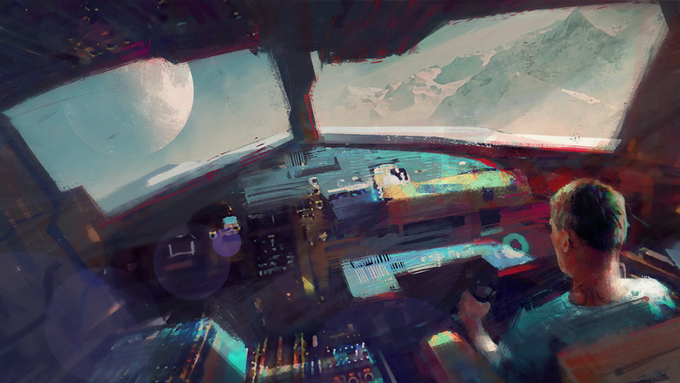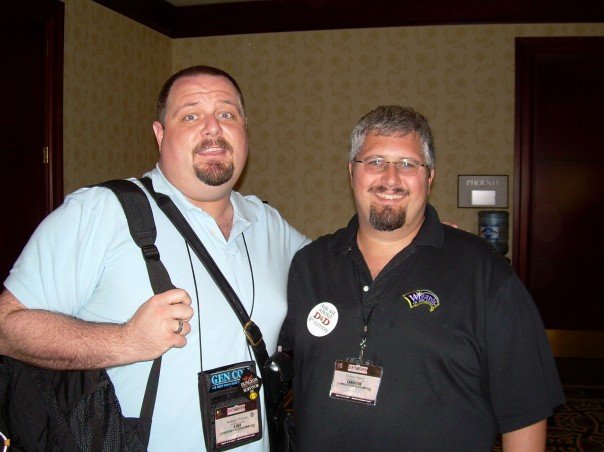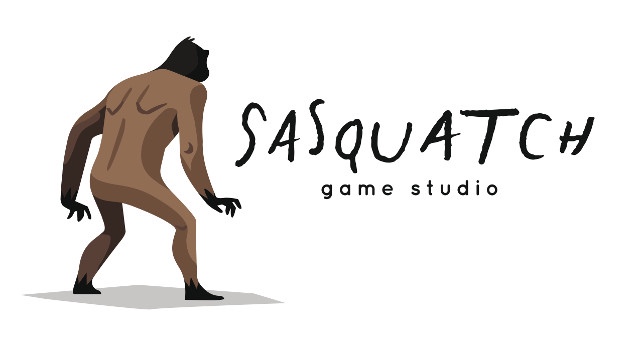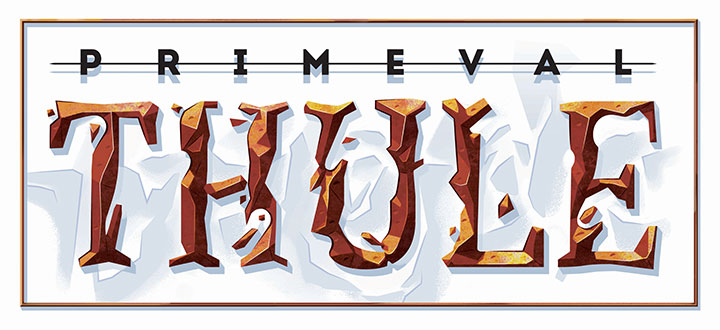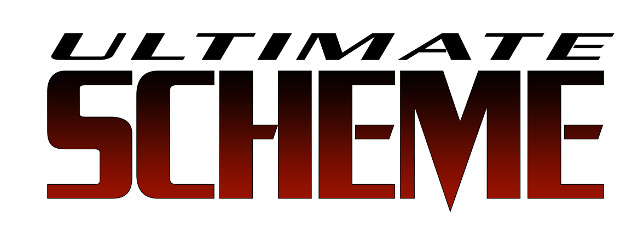I’ve talked about Alternity here in the blog before. Both Stargazer and myself are fans, and have posted about it numerous times. We even had an April’s Fool post back in 2011 about a 2nd edition of the game coming out. Who knew we were not merely pranksters but we were predicting the future!
Well not quite… Like Michael wrote last year when the initial announcement came out, Sasquatch Game Studio is publishing a new version of the game. As a longtime fan, I was onboard as soon as the idea was put out there. When the Alpha play test came out I was lucky enough to be part of that.
I got together with some friends at out FLGS and we played the play test adventure. We tried to broadcast the experience via Facebook Live, and while that was not totally successful, it did inspire us to create a video blog for Spanish speaking gamers Desde la Fosa. (You can read more about that project on the post I linked to in that last hyperlink.)
As soon as the new Alternity Kickstarter was live I became a backer. Wanting to support the project and spread the word I reached out to Richard Baker to inquire about his availability for an interview. Richard was extremely graceful and not only did he answer a written interview, which makes up most this post, but he sat down to do an interview for the Desde la Fosa vlog via Google Hangout. So, we are doing a two-for-one, and the first collaboration between Desde la Fosa and Stargazer’s World!
This is part one of that collaboration. The written Interview with Richard Baker about the new Alternity project. It’s a rather lengthy piece, so let’s get right on with it!
My picture with Richard at GenCon 2005
Sunglar: Richard, I’m aware of your long and storied history as a game designer, but for the benefit of our readers who might not be as familiar. Who is Richard Baker? When and how did you begin playing RPG games?
Richard: First of all, let me say I’m happy to be here! I’m Rich Baker, and I’m a lifelong gamer and sci-fi fan. I’m also fortunate enough to have been able to make a career out of game design and writing fantasy and science fiction. As far as my start in RPGs . . . in 1978 I discovered a group of my classmates playing a strange game in the local hobby store. I was there for model-building stuff, but the cover of the 1st Edition Monster Manual immediately fired my imagination. I came back the next day to buy the old blue-box Dungeons & Dragons game. So, I suppose I’ve been playing for something like 39 years now!
Sunglar: How did you begin working as a professional game designer?
Richard: In the spring of 1991, I finished up my active duty in the US Navy and decided to see what was out there for me in the civilian world. I sent resumes out to something like fifty different companies. Then, for the pure hell of it, I sent one to TSR, Inc., too. I didn’t have any idea if they were looking for game designers or not, but as it turned out, they were. They sent me a Complete Viking Handbook and a design test: Write a 2000-word encounter based on the material in the sourcebook. I figured, “Sweet! I just scored a free D&D book!” I suppose the folks at TSR liked my design submission, because they brought me out for an interview and hired me on a few months later.
Sunglar: You worked at TSR and them switched over to WotC. How was that transition?
Richard: It was pretty challenging. TSR basically stopped publishing late in 1996, and all of us in the creative team knew that we were on thin ice. I had a pretty cool project to keep me going, though: the Alternity science-fiction game. Bill and I kept working on Alternity all through those dark months. It was a lot better to come into the office and throw myself into a project than to stare at the cube walls and wait for a layoff notice!
Luckily the gamers who ran Wizards of the Coast loved D&D as much as we did and had the wherewithal to take advantage of the opportunity to acquire TSR. I had a good deal of anxiety about the prospect of moving to the Seattle area, but the fact that dozens of my colleagues (and close friends) were all heading out to the West Coast at the same time made the decision easy for me.
Sunglar: How long did you work on AD&D/D&D directly at TSR and WotC?
Richard: Just about twenty years. I started in October of 1991 and continued until December of 2011. There was a brief period after 3rd Edition came out when I ran the Alternity team instead of working on D&D, and I also had a few months away from D&D here and there to work on the Axis & Allies Miniatures games. But I was never very far from D&D in all that time.
Sunglar: This question may be like asking a parent, who your favorite child is… What are some of the books and supplements that you’ve worked on that stand out for you?
Richard: That’s really a tough one. In no particular order, I suppose I’d say I’m most proud of 3rd Edition D&D (I invented things like feats, the sorcerer, and the warlock), the Birthright Campaign Setting, the original Alternity, 3rd Edition Forgotten Realms, 4th Edition Dark Sun, and our Primeval Thule Campaign Setting. I also greatly enjoyed working on Axis & Allies Naval Miniatures—I still can’t believe WotC paid me to design that game.
Sunglar: How did Sasquatch Game Studio came to be?
Richard: In 2013, I went to work on Pathfinder Online with Goblinworks, right in the same building with Paizo. It’s a 40-mile commute, and it takes an hour and 15 minutes each way. That gave me a lot of time to think in my car. I used to pass the time by asking myself the question, “If I could make any game I wanted, what would that be?” The answer I came up with was Primeval Thule. So, I summoned my good friends (and former WotC colleagues) Steve Schubert and Dave Noonan to a clandestine meeting in a dubious bar, which is how all good adventures begin. They loved the idea of teaming up to make great games, so I parted ways with the Goblinworks crew (good guys; it’s a shame that Pathfinder Online just didn’t get traction) to devote my attention to launching Thule. Four years later, here we are!
Sunglar: What was working on the Princes of the Apocalypse adventure for D&D 5th edition Like? How did that come about?
Richard: I maintained cordial relations with my former colleagues after WotC decided to eliminate my position in 2011, so I did a little design work for them here and there after becoming a free agent—most notably, the Lost Mine of Phandelver adventure in the D&D Starter Set. And naturally Mike Mearls, Chris Perkins, and the rest of the D&D team was aware of the work Dave, Steve, and I did in publishing Primeval Thule on our own. So Sasquatch was on their short list when they started looking around for a creative shop to partner up with in a studio agreement.
Princes of the Apocalypse wound up being a very challenging project for us. We were working on a big book with a short deadline, and it really swamped us. But I am very happy with the way the book turned out—there is a *ton* of great adventure there.
Sunglar: What products may our readers know by Sasquatch Game Studio?
Richard: Our signature publications are Primeval Thule, Princes of the Apocalypse, and (now) Alternity. We’re small, so we focus on doing one thing at a time and doing it well.
Sunglar: What might they have missed?
Richard: We recently published a fun little take-over-the-world boardgame called Ultimate Scheme. I think *everyone* missed that, unfortunately. We had a hell of a time getting any attention at all for that Kickstarter. But it’s a great game, and it’s worth picking up. I’d also point out several fun adventures and handbooks for Primeval Thule, available as PDFs or as print-on-demand through DriveThruRPG. If you liked Thule, you might like those adventures!
Sunglar: I know there is a little new project you are Kickstarting right now, one I might be sort of excited about… When did you decide to bring Alternity back?
GenCon of 2015. Dave, Steve, and I were driving from Chicago to Indy, and we took advantage of that time to indulge in some pie-in-the-sky planning. We’d kicked around the idea of Alternity once or twice before, but that car ride was where we committed to the idea… right after we got our Ultimate Scheme game finished.
Sunglar: Why Alternity? Why not call it something else?
Richard: Well, we realized that when we were talking about a sci-fi RPG engine that could cover just about any world or setting you wanted to play, we were talking about something similar in scope and vision to the old Alternity game. And since I had worked on the 1997 Alternity and I knew that Bill Slavicsek had an interest in seeing that idea revived in some form, it seemed like a natural fit. We know that, with the benefit of twenty years’ more experience in the game design business, we can build a better, simpler, more versatile, and more flexible SF game than the one we created in 1997. But we hope that the same love for the genre and invitation to explore fascinating worlds still shines through. That’s why we called our new game Alternity.
Sunglar: I’ve played the play test and the beta test rules, participated on the feedback, so I can attest to the work being done. How has that process been? Have the results surprised you in any way? Taken the design in any unexpected direction?
Richard: Actually, we sketched out the basics of the system pretty quickly. What we haven’t done yet is to elaborate on the design: filling out skill descriptions, creating a full menu of talents, expanding the gear table, and so on. I’d say that the biggest surprise to me so far is the initiative system. Dave brought the idea for the system to the rest of us, and I thought he was kind of nuts. But after playing with the impulse system for many weeks, I think it’s really solid. It’s a clear improvement on the action round of the old game, and it lets you do some fun and different things than a D20-like action economy would. I think it’ll really shine in the vehicle rules—I’ve been experimenting with some as I’m working on our Thunder Run adventure.
Sunglar: I understand you registered the trademark as the old one had been abandoned, and that you don’t have access to the intellectual property. But you still can improve upon the core mechanics that were developed back then. What do you think worked back then that you adapted and what would you say was your priority to work on design wise?
The core mechanic—adjusting difficulty by using different polyhedrals—is one of the signature elements of the old game, and something we definitely wanted to incorporate in our new design. Likewise, we think it’s important to present Alternity as a skill-based game system. As far as things we think needed work . . . well, I just mentioned the action round of the original game. Roll-each-round initiative is just tedious. We’re also working on encounter-building systems so that a GM can have some confidence about what kind of challenge a particular group of foes really presents to the heroes. That was sorely needed in the original!
Sunglar: The control die + situation die mechanic always seemed to me as a great mechanic ever since I first played Alternity, and was excited you see that you kept it. I Also liked that you made it roll high. Have new players that participated in the pay test made you look at it with fresh eyes in any way?
Ok I’ll ask about what my players complained about the most, the initiative system. While I had a little trouble grasping it at first I think by the time we played I managed it efficiently. Some of my players got it, others I had to guide along, but overall it was the last favorite part of the playtest. Have you done any additional design work on it?
Richard: I’ll admit that I was pretty skeptical about the initiative system at first. Dave proposed the impulse system and insisted that it was working great in his home playtest, but I thought we ought to stick to something closer to a d20 game’s cyclic initiative. You can’t properly evaluate new things unless you give them a fair try, though, so I played though Dave’s system for several weeks. And to my surprise, Dave convinced me that he had a fun, workable system that provided better “sim value” and player engagement than a D&D style “take your turn, and then check out for half an hour” system. Part of being a good game designer is being open to new ideas and seeing where they lead you!
I will note that the impulse initiative system works *way* better if you use tokens on an initiative tracker of some kind. We’re going to make sure we include one with the game release.
Sunglar: Is the initiative system going to differ in any significant way from the play test?
Richard: We need to fine-tune some scaling of character speed and weapon ranges, but right now we’re planning on proceeding with the system we’ve got . . . subject to some playtest feedback, of course. If we get a strong majority of our playtesters reporting that the system is a deal-breaker, we should pay attention to what they’re saying. If we get a mix of “love it,” “like it,” “works okay,” and “don’t like it”—which is pretty much what we’ve seen so far–we’ll probably keep what we have and work to improve it.
Sunglar: What about character durability? In my play test, the players found their heroes resistant to damage and able to take up any of the challenges in the play test adventure. I know you are asking for feedback on that currently? What are your thoughts on this right now?
For myself, I worry that characters might be a little too durable. I’d rather see PCs tough out a lot of damage by spending hero points to mitigate hits instead of just soaking up bullet after bullet. On the bright side, it’s easy to adjust our rules on building durability tracks so that characters get a few more or a few less boxes. But before we do that, we want to know if we’re observing a real problem or not. That’s why we asked for feedback!
Sunglar: After those two gripes, let me make clear there was a LOT more I liked in the play test, and on its strength backed the project as soon as I was launched. What do you think I the biggest strength of this redesign?
Richard: I guess I’d say that the combination of a fun, flexible die mechanic with a clean ability + skill point system is what makes the new Alternity really sing. We’re also going to make some big improvements on the GM’s side of the screen by adapting some of the great monster design philosophy we worked out in, say, D&D 4th Edition, to the task of balancing combat encounters and making adversaries fun and easy to run. That’s really just been hinted at in our Quickstart Guide, but believe me, it’s going to make a big difference in the quality of your experience.
Sunglar: The old system had a pseudo level based advancement. How has that changed in the new version? Did you keep anything or did you rework that?
Richard: We’re leaning toward a more narrative leveling experience, rather than tracking encounters or adversaries defeated. We’re also trying to move past the “zero to hero” philosophy that the old Alternity game shared with the D&D game at the time. We think a 1st-level Alternity hero is already a tough, competent, resourceful protagonist in his or her story. You won’t be ten times tougher when you hit 10th level, but you’ll have plenty of skill points and talents to create just about any sci-fi hero you’d want to create.
Sunglar: For me one of the strengths of Alternity was the fact that it was a sci-fi toolbox. Is that still the idea behind the game? How much of the Protostar setting is in the rules?
Richard: Oh, yes, definitely so. We’ll cover campaign design, tech levels, game planetography, and lots of other toolbox-like topics in our Core Rulebook. We want to give you the tools you need to build the sci-fi game you want to run. We’ll use Protostar as a “designated example” and we’ll probably include a campaign overview and short adventure as a way of illustrating how the game works, but we fully expect many GMs will decide to do their own thing with the Alternity game. And we think that’s great!
Sunglar: The original Alternity had some memorable Campaign settings. Is this a model you’d like to continue in the new Alternity?
Richard: Yes, and no. While we love writing big books full of ideas and storylines for interesting places (for example: Primeval Thule!) we think the most useful thing we can provide for the GM is adventure content and ready-to-use pieces like aliens, gear, and villains. The Protostar Mission Guide is 90 percent adventure and 10 percent sourcebook—we think that the adventures you have in Protostar create the campaign, not the other way around.
Sunglar: What can you tell us about the Protostar setting? Did we see glimpses of it in the play test rules?
Richard: You did—the Wreck of the Magellan adventure in the Quickstart Guide is a pretty typical Protostar experience. We’re planning to write up a meaty development blog piece on Protostar in the next week or so at sasquatchgamestudio.com (and in fact it might already be posted by the time this interview is published).
Sunglar: What genres of science fiction will the Alternity rules support in the rulebook?
Richard: Modern to far-future action, space opera, espionage, heists, and horror should all be covered pretty well. JLA-class superheroes, post-singularity or transhuman settings, or science fantasy might be a little outside our initial mandate, but we hope to broaden our scope with future sourcebooks if the audience is interested in those topics.
Sunglar: Are there rules to create new aliens in the main book?
They’re not in the book yet, but we’re not done. We’re likely to include some guidance in the GM-focused chapters before we’re finished.
Sunglar: How bit are the other two books in the Kickstarter campaign Protostar Mission Guide and The Shipyard?
Richard: At the moment, we’re saying 64 pages each. However, we expect that stretch goals will add a substantial amount of content to those books. I doubt they’d go over 96 pages, simply because if we’re adding that much new content, we’d probably just add a whole new sourcebook.
Sunglar: The rules for ships and ship construction will be in the separate book The Shipyard?
The Core Rulebook includes a pretty good vehicle interface and a decent selection of vehicles (and ships) for characters to make use of or blow up. Every GM’s going to need to know something about how cars, fighter jets, and tramp star-freighters work. Actual ship construction systems are a little outside the scope of the core rules. They’ll fit a lot better in The Shipyard, along with plenty more examples of interesting ships.
Sunglar: I like the art I’m seeing in the Kickstarter updates. A big part of the original Alternity was the amazing art. What can about tell me about the graphic design and the artists working in the new Alternity books?
Richard: We plan to work with Corey Macourek to develop our page design. He’s the guy who created the page design for our Primeval Thule Campaign Setting and our Ultimate Scheme rulebook. The page design you see in the Quickstart Guide isn’t the final page layout that you’ll see in the actual Core Rulebook.
As far as artists, we haven’t commissioned much yet, so I don’t know for sure who we’ll be able to get. (That’s one of the reasons we’re running the Kickstarter!) We plan to work with Christoper West and Sean Macdonald on our cartography, and we’d like to continue working with our concept artists Ayan Nag, Roberto Gatto, and Lee Smith for interior illustrations. Between Primeval Thule and Princes of the Apocalypse, we’ve built up a decent “stable” of artists we can go to for the balance of the illustration work.
Sunglar: How is Bill Slavicsek involved in the design o the new game? Who else is working on the game?
Richard: Bill’s got a pretty cool day job working on Elder Scrolls Online, so he’s limited in his availability for big design assignments. We involved him in some of the early brainstorming and concept work, and he’s provided us with lots of feedback and suggestions on our playtest materials. When our project funds, we’ll be able to bring him in to take on some more hands-on writing work, and we’re already planning on inviting Bill to write a Protostar adventure for us. We’re also planning to work with Bill’s wife Michele as our lead editor. She’s got a list of game credits just as long as mine is, and she’s the best.
Sunglar: Your estimated delivery as stated in Kickstarter is December 2017 (so I can star planning my 2018 campaign). How far along would you say are you in the design process?
Richard: We have about 8-10 weeks of writing left, followed by 4-6 weeks of development, 4-6 weeks of editing, and 3-4 weeks of layout work. We can’t really *start* on the remaining writing until we know our Kickstarter campaign is successful. If we stay on schedule, we’ll send files to the printer in mid-October. Since we’re printing in the US, we should have books back by Thanksgiving. I will point out that if we wind up adding more sourcebooks through stretch goals it might take us a little longer to pull those all together, but the Core Rulebook is our top priority.
Sunglar: Anything else you’d like to tell our readers about Alternity, Sasquatch Game Studios or any other projects you have?
Richard: I feel like I’ve said plenty already, but . . . if you’re on the fence about our project, I’d encourage you to go on over to DriveThruRPG.com and download our playtest packet. Try it out for yourself and see if our vision of Alternity is worth your support. You might also take a look at our track record on Primeval Thule or Princes of the Apocalypse. We believe in producing top-quality games for discerning gamers, and Alternity is no exception. I think you’ll like what we’re doing!
Sunglar: Ok I’ll admit that this is a little extensive… Depending on your responses I may even split up the blog post in two. I hope they don’t seem like overkill. Again, thank you so much for the opportunity.
Richard: You’re welcome! And thank you for helping to draw attention to our project!
That concludes the interview with Richard Baker for Stargazers World. After this written interview, I sat down via Google Hangout and talked for about an hour with Richard about the new project, the history of the Alternity Game and a few other details about his projects through the year. You can see the Interview in this video:
I hope all the information, here and on the video, was interesting and that you check out the new Alternity. Like Richard said in the video, if you are in the fence about it, check out the beta play test rules at DriveThruRPG.
If after all this you are still curious about how our play test of the Alternity rules went, you can watch the videos on Facebook. Be warned, first they are in both English and Spanish (we switch around to both), and second, we had some technical issues, like not having a proper microphone and the cellphone battery dying out on us. Still it is a glance on now we started on the road to this new project. Here are the links to session 1, part 1 and part 2, and session 2, part 1 and part 2.
Thanks for reading, and have a wonderful week!

